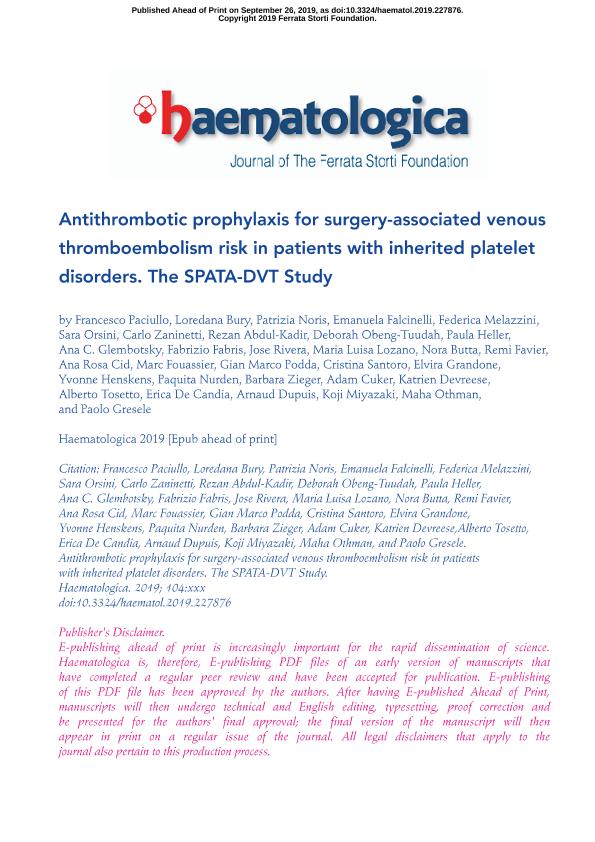Artículo
Antithrombotic prophylaxis for surgery-associated venous thromboembolism risk in patients with inherited platelet disorders. The SPATA-DVT Study
Paciullo, Francesco; Bury, Loredana; Noris, Patrizia; Falcinelli, Emanuela; Melazzini, Federica; Orsini, Sara; Zaninetti, Carlo; Abdul Kadir, Rezan; Obeng Tuudah, Deborah; Heller, Paula Graciela ; Glembotsky, Ana Claudia
; Glembotsky, Ana Claudia ; Fabris, Fabrizio; Rivera, Jose; Lozano, Maria Luisa; Butta, Nora; Favier, Remi; Cid, Ana Rosa; Fouassier, Marc; Podda, Gian Marco; Santoro, Cristina; Grandone, Elvira; Henskens, Yvonne; Nurden, Paquita; Zieger, Barbara; Cuker, Adam; Devreese, Katrien; Tosetto, Alberto; De Candia, Erica; Dupuis, Arnaud; Miyazaki, Koji; Othman, Maha; Gresele, Paolo
; Fabris, Fabrizio; Rivera, Jose; Lozano, Maria Luisa; Butta, Nora; Favier, Remi; Cid, Ana Rosa; Fouassier, Marc; Podda, Gian Marco; Santoro, Cristina; Grandone, Elvira; Henskens, Yvonne; Nurden, Paquita; Zieger, Barbara; Cuker, Adam; Devreese, Katrien; Tosetto, Alberto; De Candia, Erica; Dupuis, Arnaud; Miyazaki, Koji; Othman, Maha; Gresele, Paolo
 ; Glembotsky, Ana Claudia
; Glembotsky, Ana Claudia ; Fabris, Fabrizio; Rivera, Jose; Lozano, Maria Luisa; Butta, Nora; Favier, Remi; Cid, Ana Rosa; Fouassier, Marc; Podda, Gian Marco; Santoro, Cristina; Grandone, Elvira; Henskens, Yvonne; Nurden, Paquita; Zieger, Barbara; Cuker, Adam; Devreese, Katrien; Tosetto, Alberto; De Candia, Erica; Dupuis, Arnaud; Miyazaki, Koji; Othman, Maha; Gresele, Paolo
; Fabris, Fabrizio; Rivera, Jose; Lozano, Maria Luisa; Butta, Nora; Favier, Remi; Cid, Ana Rosa; Fouassier, Marc; Podda, Gian Marco; Santoro, Cristina; Grandone, Elvira; Henskens, Yvonne; Nurden, Paquita; Zieger, Barbara; Cuker, Adam; Devreese, Katrien; Tosetto, Alberto; De Candia, Erica; Dupuis, Arnaud; Miyazaki, Koji; Othman, Maha; Gresele, Paolo
Fecha de publicación:
09/2019
Editorial:
Ferrata Storti Foundation
Revista:
Haematologica
ISSN:
0390-6078
e-ISSN:
1592-8721
Idioma:
Inglés
Tipo de recurso:
Artículo publicado
Clasificación temática:
Resumen
Major surgery is associated with an increased risk of venous thromboembolism, thus the application of mechanical or pharmacologic prophylaxis is recommended. The incidence of venous thromboembolism in patients with inherited platelet disorders undergoing surgical procedures is unknown and no information on the current use and safety of thromboprophylaxis, particularly of low-molecular-weight-heparin in these patients is available. Here we explored the approach to thromboprophylaxis and thrombotic outcomes in inherited platelet disorders patients undergoing surgery at venous thromboembolism-risk participating in the multicenter SPATA study. We evaluated 210 surgical procedures carried out in 155 patients with well-defined forms of inherited platelet disorders (venous thromboembolism-risk: 31% high, 28.6% intermediate, 25.2% low, 15.2% very low). The use of thromboprophylaxis was low (23.3% of procedures), with higher prevalence in orthopedic and gynecological surgeries, and was related to venous thromboembolism-risk. The most frequently employed thromboprophylaxis was mechanical and appeared to be effective, as no patients developed thrombosis, including patients belonging to the highest venous thromboembolism-risk classes. Low-molecular-weight-heparin use was low (10.5%) and it did not influence the incidence of post-surgical bleeding or of antihemorrhagic prohemostatic interventions. Two thromboembolic events were registered, both occurring after high venous thromboembolism-risk procedures in patients who did not receive thromboprophylaxis (4.7%). Our findings suggest that venous thromboembolism incidence is low in patients with inherited platelet disorders undergoing surgery at venous thromboembolism-risk and that it is predicted by the Caprini score. Mechanical thromboprophylaxis may be of benefit in patients with inherited platelet disorders undergoing invasive procedures at venous thromboembolism-risk and low-molecular-weight-heparin should be considered for major surgery.
Archivos asociados
Licencia
Identificadores
Colecciones
Articulos(IDIM)
Articulos de INST.DE INVEST.MEDICAS
Articulos de INST.DE INVEST.MEDICAS
Citación
Paciullo, Francesco; Bury, Loredana; Noris, Patrizia; Falcinelli, Emanuela; Melazzini, Federica; et al.; Antithrombotic prophylaxis for surgery-associated venous thromboembolism risk in patients with inherited platelet disorders. The SPATA-DVT Study; Ferrata Storti Foundation; Haematologica; 105; 9-2019; 1948-1956
Compartir
Altmétricas



